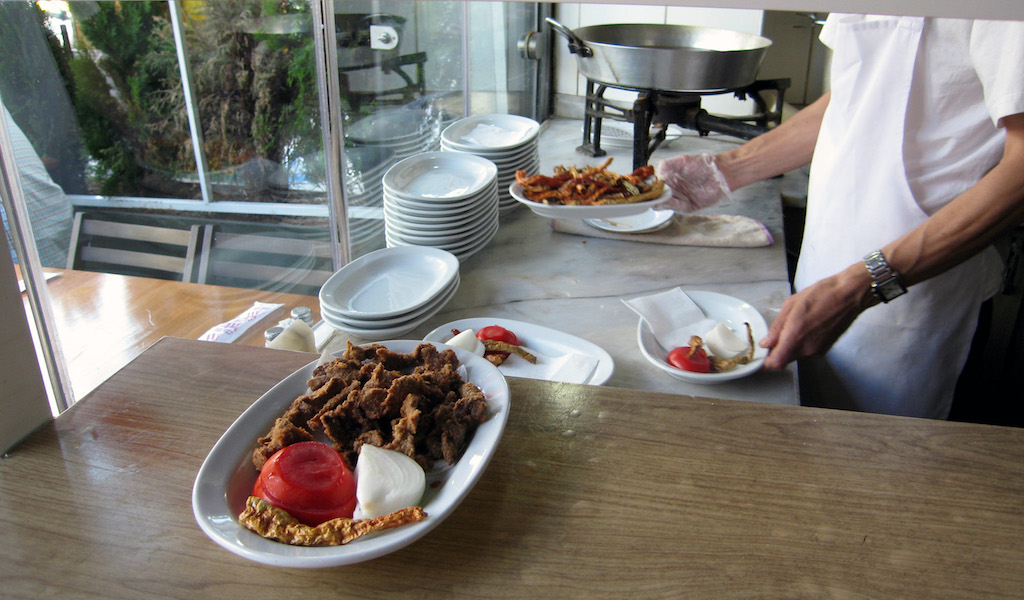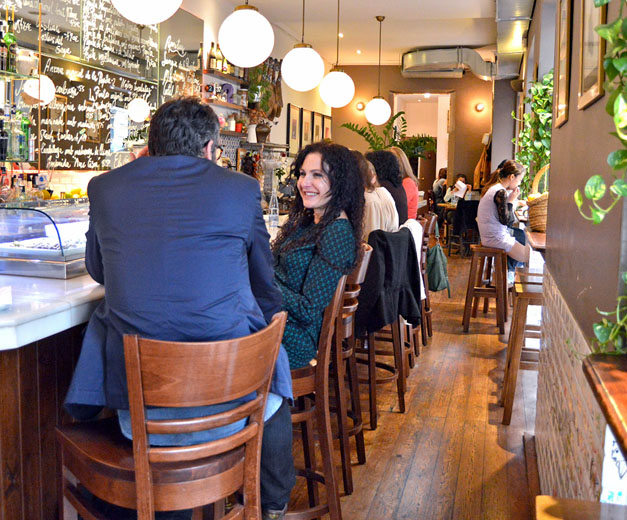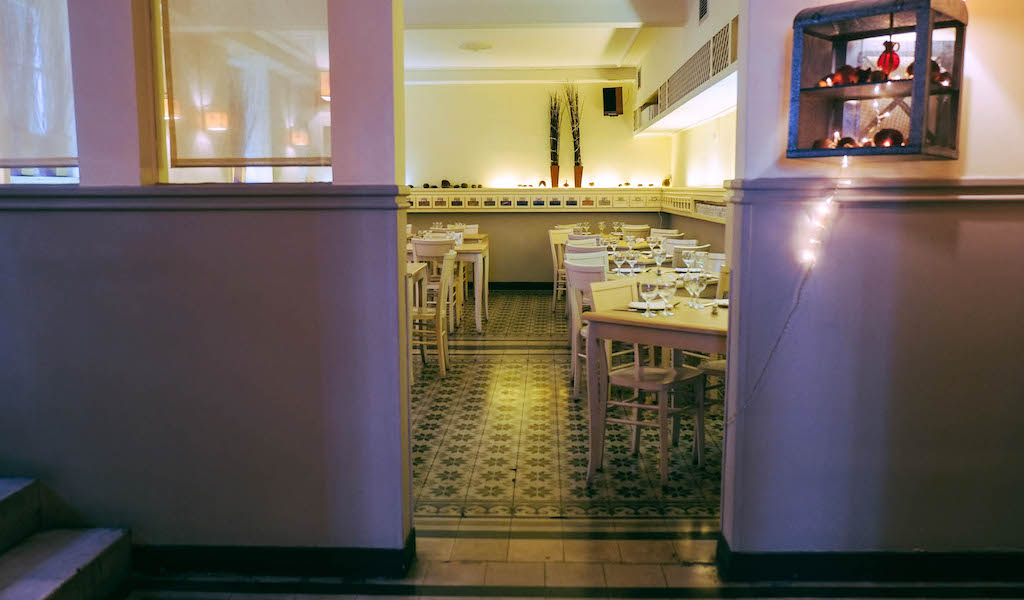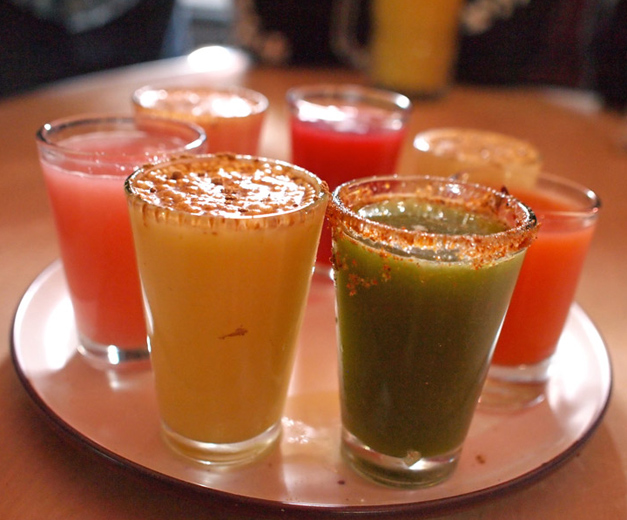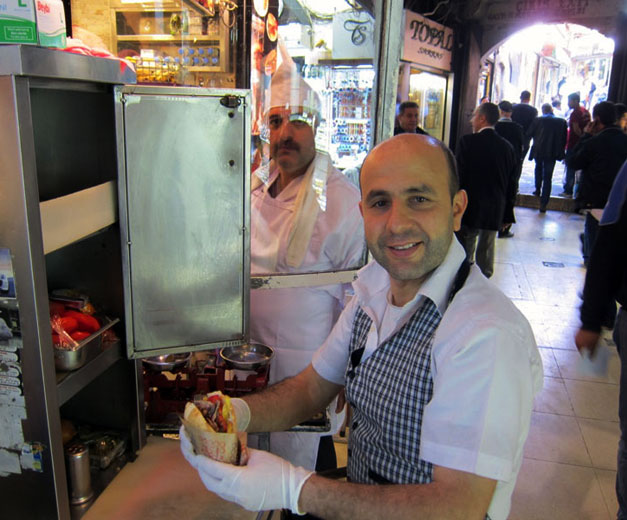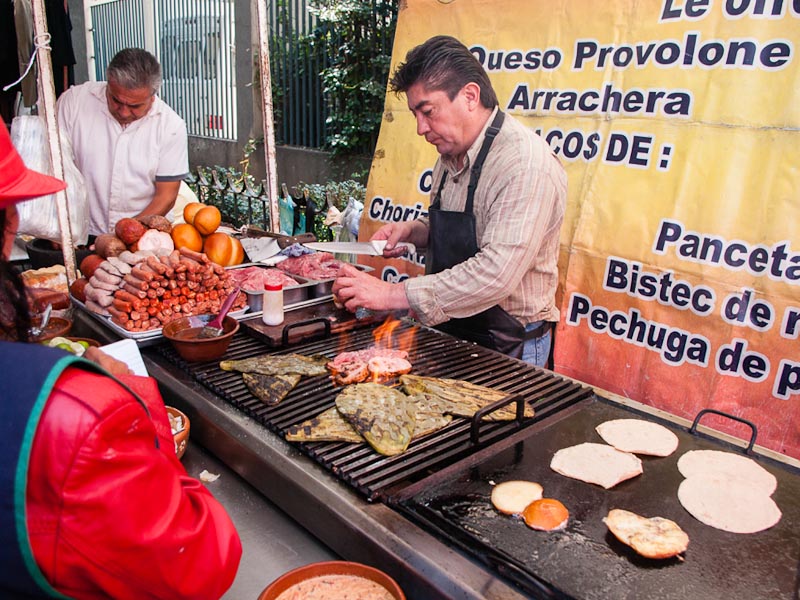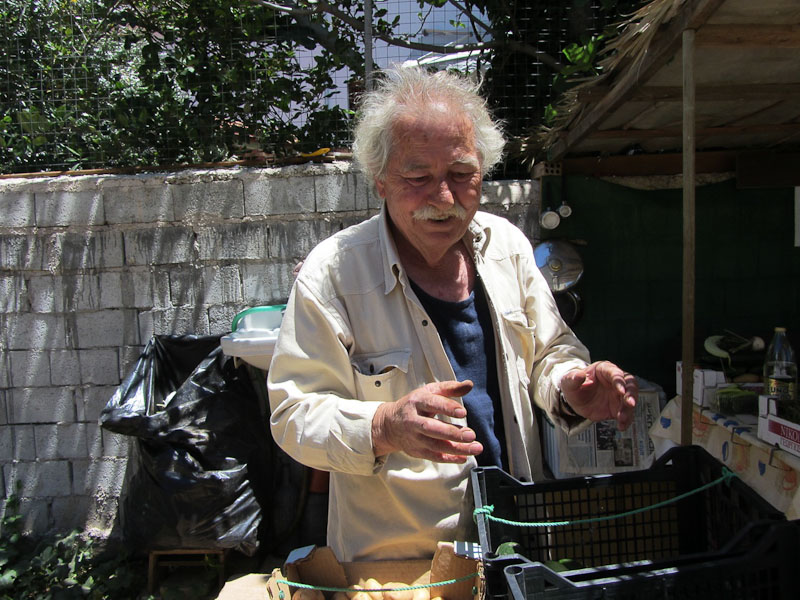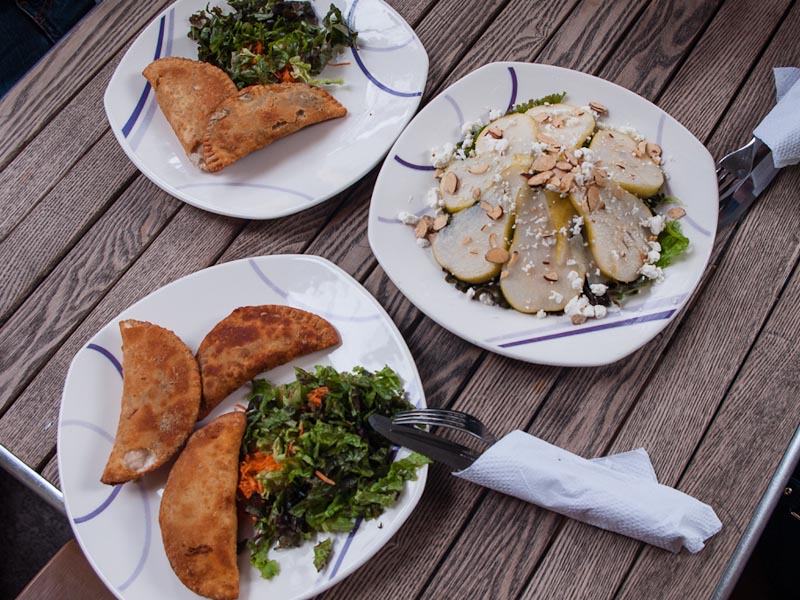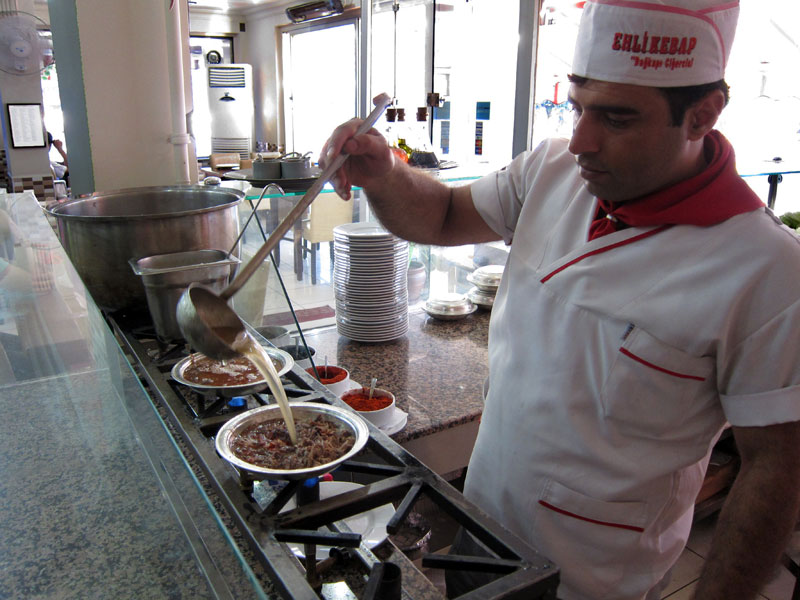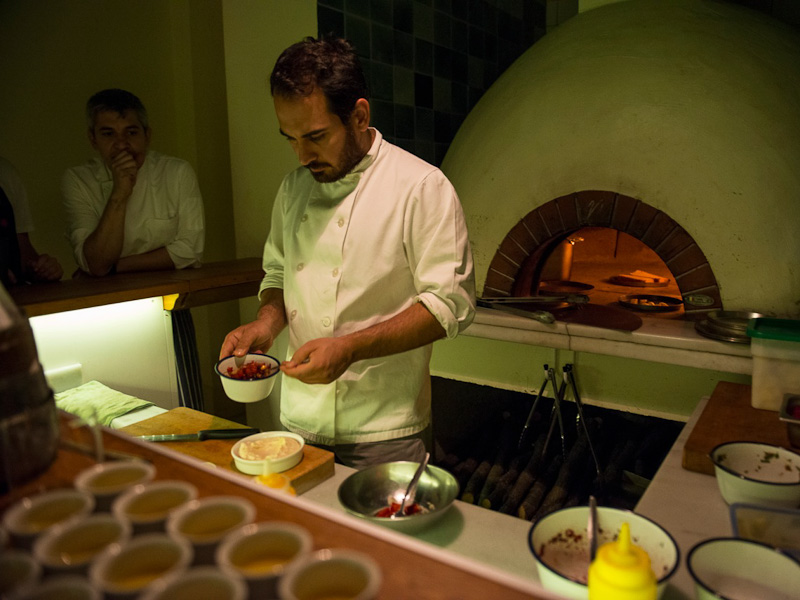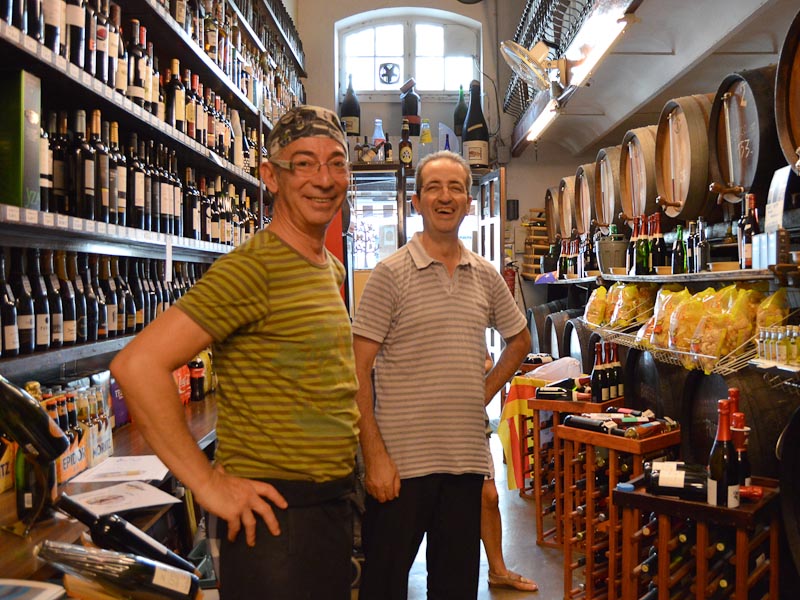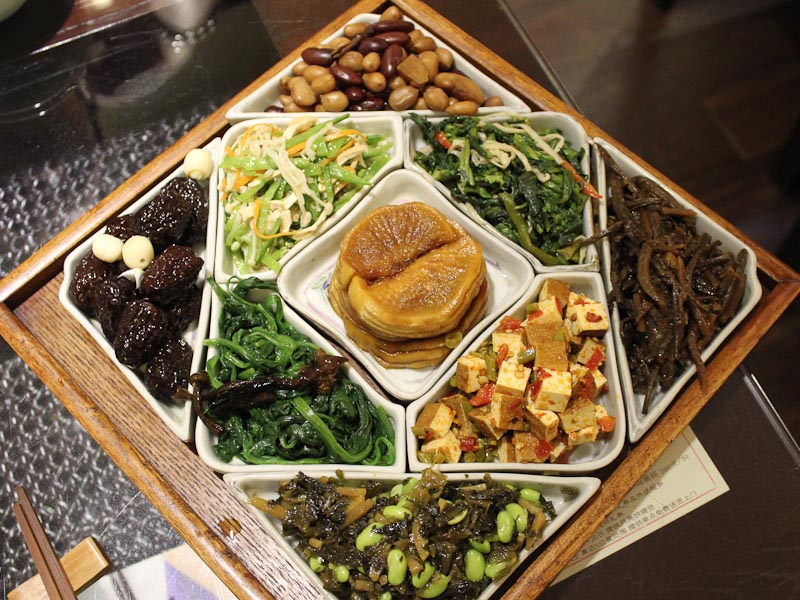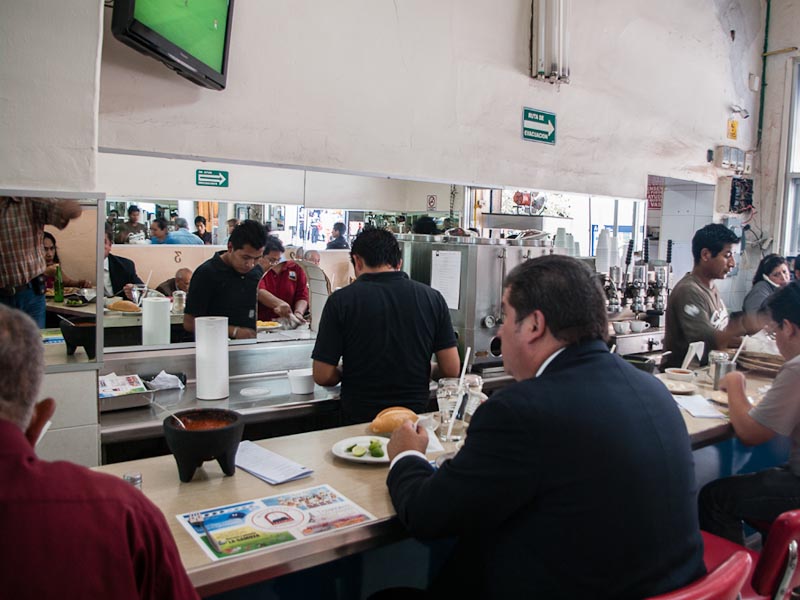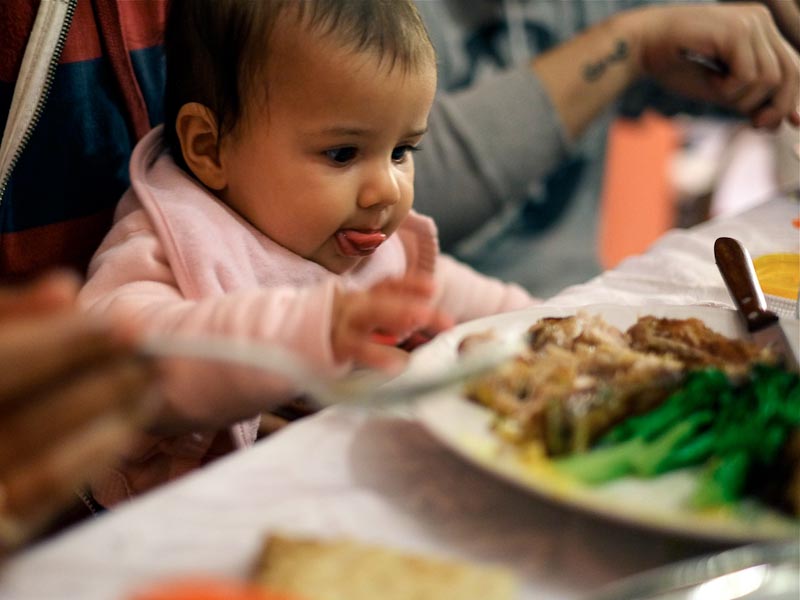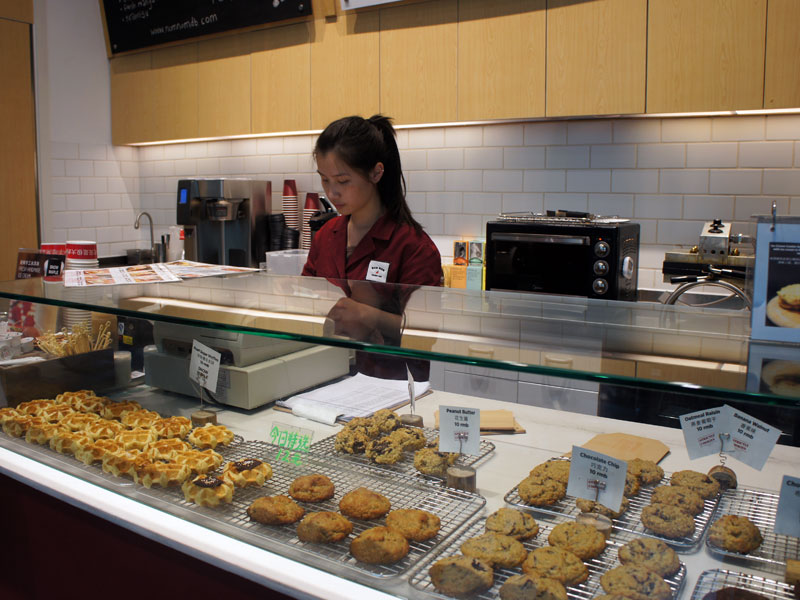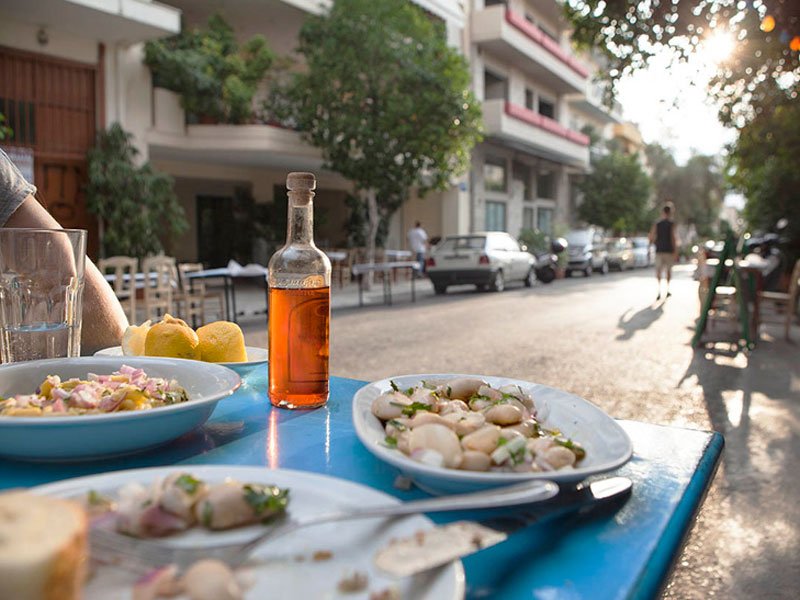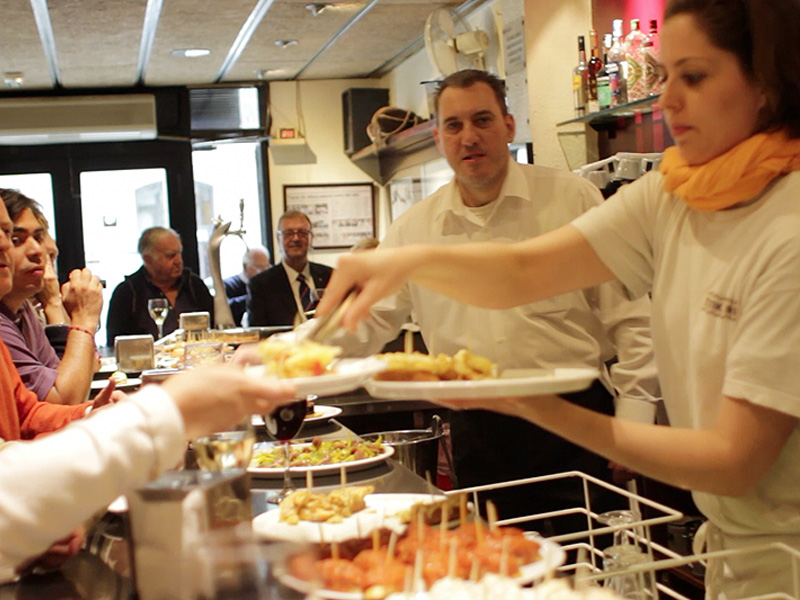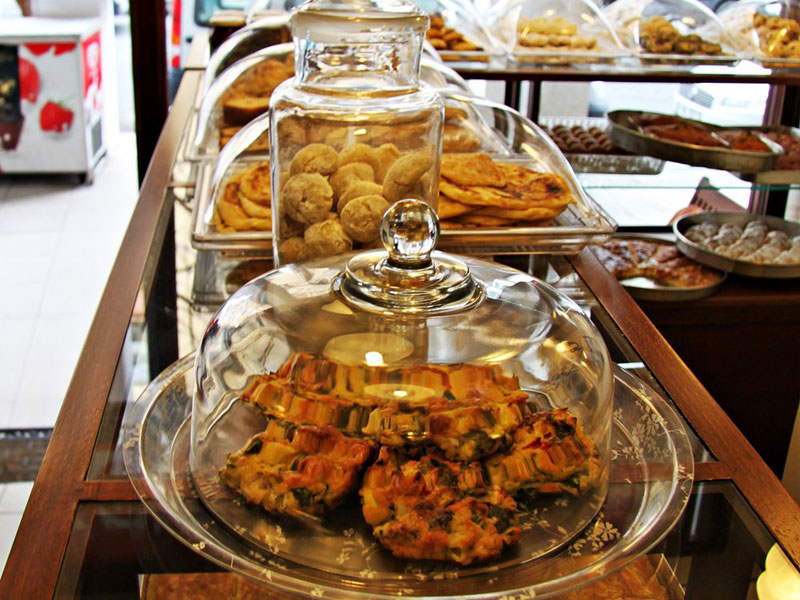We can't find the internet
Attempting to reconnect
Something went wrong!
Hang in there while we get back on track
Search results for
Istanbul
Can Ciğer: For the Liver Lover in You
Editor's Note: Unfortunately, this spot is no longer open. We’ve written previously about Turkey’s passionate love affair with liver, one that can turn downright obsessive in some parts of the country. Edirne, an old Ottoman capital city about two hours out of Istanbul, is one of those places. Filled with restaurants selling the dish and nothing but, Edirne is perhaps ground zero for Turkish liver lovers. If the city’s countless liver restaurateurs had their way, Edirne’s official symbol would probably be the organ, with a giant, quivering liver sculpture greeting hungry travelers at the entrance to town. Of course, that kind of boosterism is unnecessary; for many Turks, the name Edirne is simply synonymous with liver.
Read moreBarcelona
La Pepita: The Barcelona Globetrotters
We’ve written a great deal about all thetraditionalCatalan, Basque and Spanish food around town, but what about the modern, globally influenced cooking that’s taken hold in the food capitals of the world – of which Barcelona is certainly one? La Pepita is a prime specimen, with its passionate, creative young owners and food that, while anchored in the tapas tradition, reinterprets classic dishes through the cross-pollination of other cultures’ ingredients and ideas.
Read moreAthens
Alexandria: Princess of Egypt
When the aptly named Cleopatra Theodoulou opened her restaurant, Alexandria, in the downtown Mouseio district in 1999, she not only helped in the revival of a once posh neighborhood that had fallen on hard times – she also created a vibrant culinary link to her family’s cosmopolitan past.
Read moreRio
Bistrô Estação R&R: Drink and Thrive
Favelas just aren’t what they used to be – or what you thought they were. Rio’s squatter settlements have grown up, though uneven development still leaves considerable gaps in terms of policing, sanitation, sewage and public services. But the favela label is increasingly arbitrary as Rio’s “slums” – we put that in quotes because we think that word often leads to some generous and inaccurate flights of imagination – start to look more like working-class bairros. And they’re working their way up to becoming the more intriguing and inviting parts of the carioca landscape.
Read moreMexico City
Pulque: A Strange Brew's Revival
Milky, tart, viscous and slightly foamy. At first glance and sip, there’s little to explain why pulque – a mildly alcoholic drink made by fermenting the fresh sap of certain types of maguey, the same plant used for making mezcal – has remained a trusted companion to Mexican drinkers since Aztec times. Pulque, actually, has not only survived, but, after decades of losing ground to beer and soft drinks and their high-priced marketing campaigns, this workingman’s brew is making a comeback. New pulquerías are popping up in hip Mexico City neighborhoods and attracting a younger crowd while old pulquerías, which endured some lean times, are seeing an influx of new customers, who now sit side-by-side with older generations of loyal pulque drinkers. Nobody really seems to know why the previously unheralded nectar has been getting this much attention in the last few years, but several places around town have been capitalizing on this new trend with great success.
Read moreIstanbul
Gülebru Kantin: Döner Redemption
We generally regard the Grand Bazaar as a place of punishment, a den of aggressive, wolf-like hustlers and innocent, lamb-like tourists wearing novelty fez hats. When we have to go, we like to think of ourselves as members of a prison SWAT team, sent in to search a cell for some specific item – Turkmen jewelry, hamam towels and, once, wedding rings.
Read moreAthens
ENOA: (Not) For Members Only
Editor's note: We're sorry to report that ENOA has closed. Situated by the sea in the marina of Agios Kosmas, ENOA is part of a truly strange neighborhood. There are a couple of nightclubs, some cottages and the enormous, badly lit rowing and sailing buildings that have been left to molder after the 2004 Olympics – but mostly the feeling is of an abandoned wasteland by the sea. The entrance to ENOA, an area club, is equally unimpressive: a number of trophies cramped behind a glass display followed by a cavernous dining room that, with its harsh, unflattering neon lights, resembles a hotel from 1960s rural Greece.
Read moreBarcelona
Capped: Catalonia's Magic Mushroom Season
Mushroom hunting has an irresistible, magical pull. Composer John Cage, an avid mushroom collector, found them an integral part of his creative process, once writing: “Much can be learned about music by devoting oneself to the mushroom.” Every fall, thousands of Catalans likewise find themselves under the mushroom’s spell, following the elusive fungus’s silent melody into the woods, a rustic wicker basket in one hand and – more and more these days – a GPS-enabled smartphone in the other.
Read moreIstanbul
In Istanbul, Making the Case for a Slow Fish Movement
Situated on a geographically blessed spot where the waters of the Black Sea and the Sea of Marmara meet, Istanbul has long been associated with fishing and, especially, the eating of fish. In culinary terms, after all, is there anything more iconic in Istanbul than eating a freshly grilled fish sandwich sold from one of the bobbing boats down by the Golden Horn?
Read moreMexico City
Spice Everywhere: Brunch, from North of the Border
Editor’s note: We regret to report that Spice Everywhere has closed. It didn’t take long after arriving from Chicago a decade ago for Juliet Lambert to figure out what was the gaping hole in Mexico City’s otherwise rich culinary scene: an American-style brunch spot. The chef went on to start Spice, a catering company, but earlier this year was able to come up with the answer to the brunch problem when she launched Spice Everywhere, a roving pop-up that is bringing hashbrowns and waffles to the land of the tortilla.
Read moreBarcelona
Bodega Manolo: More than Meets the Eye
At first glance, Bodega Manolo seems like the usual wine shop/tapas bar that Barcelona does so well: a solid place to replenish our wine stocks from the barrels, quench our thirst with a cold caña or satisfy our hunger pangs with a vermut and a tapa or two of oil-drenched anchovies. None of which sound too shabby. However, we know to venture through to the rear, where, at dinnertime, the brilliant white tablecloths reveal the venue’s greater ambitions.
Read moreMexico City
El Parrillón: Gaucho Tacos
Tacos are everywhere in Mexico City, and though the options are many – chicken, al pastor, carnitas, carne asada – the basic ingredients tend to be the same wherever you go. That’s why, as we were walking the aisles of Tianguis La Raza on a Sunday morning, El Parrillón caught our attention.
Read moreAthens
How Petros's Gardens Grow
I’m sitting in the shade of a gardener’s shack with a mad man. At least, that’s what he says he is, though his cloud of white hair, smiling face and cordial manner are reassuringly benign. The garden itself is an ebullience of tomatoes, potatoes, zukes, cukes and eggplant and is especially unusual in Kifisia, the affluent suburb north of Athens, where lawns are prized as a status symbol.
Read moreShanghai
CB on the Road: Chengdu's Spicy Noodles
It’s been two weeks of cycling through China’s Qinghai province, and the food selection is slim. The majority of the province sits on the vast Tibetan Plateau, well above the tree line in conditions too harsh for significant cultivation. Yaks graze on well-trampled grass as far as the eye can see, with white yurts and colorful prayer flags dotting the hillsides and each summit pass. By Chinese standards, six million inhabitants in the country’s fourth-largest province make Qinghai practically deserted. For long stretches, only nomadic yak herders can be spotted between the tiny villages. Stopping for a roadside lunch in the small, isolated towns inevitably means a bowl of either mutton or yak chopped-noodle soup (羊肉面片, yángròu miàn piàn or 毛牛肉面片, máo niúròu miàn piàn). Served up in a tomato-chili broth, it’s a tasty meal, but repeated daily, it inevitably becomes tiresome. Additional ingredients sometimes includes julienned zucchini or green peppers, depending on the remoteness of the particular town and their staggered vegetable shipments. After just one week, we’re eagerly awaiting more fruitful pastures, and Sichuan province, located just to the east on our route, is a culinary paradise.
Read moreIstanbul
İnebolu Pazarı: Shroomin' à la Turca
“You can eat these raw, efendim!” shouted Aziz Bey to a suspicious woman dressed in a headscarf of sharp geometric designs and a denim duster. “Don’t be scared!” he said, ripping the cap off of a raw kokulu cincire mushroom with his teeth and chewing it in an exaggerated, open-mouthed way to show that there were no tricks. “Mis gibi!” he said, using a phrase that is more frequently printed on laundry detergent bottles or uttered by mothers doting over infants. “Fragrant!” In Turkey, many people assign much of what happens throughout the day to kismet, or fate, but when eating wild mushrooms you might be tempting it. Every year, it seems, local papers report on someone’s demise by mushrooms, which explained why the woman in the duster was reluctant to finish the transaction.
Read moreBarcelona
La Perla de Oro: Tapas with a French Accent
Anouchka hails from Extremadura, land of jamón and some of Spain’s best dry-cured sausages. Julien is French and an expert on wine. Together, the husband and wife run La Perla de Oro (“The Gold Pearl”), a pint-sized former colmado (old-style grocery) just off Las Ramblas, where top-notch bocadillos, or baguette sandwiches, are just one of many attractions. Since opening in 1939, three generations at La Perla have supplied their Raval neighbors with cured sausages, cheeses, preserved foods, salted fish and dried legumes. They became known especially for their bocadillos.
Read moreMexico City
Comichurros & Empanadas: Deep-Fryer Superheroes
Update: This spot is sadly no longer open. On a quiet street in Cuauhtémoc, just blocks away from some of Mexico City’s most recognizable landmarks, a slick, colorful sign and unusual name – Comichurros & Empanadas – call out loudly for attention. Inside, the place buzzes with youthful energy and social media and branding savvy: the walls are boldly decorated with floor-to-ceiling drawings of superheroes, onomatopoeic sound effects both old and new (“BAM! THWOK! CHURROS!”) and signs offering customers free churros in exchange for likes, check-ins and tweets. This is an eatery for the 21st century.
Read moreShanghai
Dunhuang Xiaoting: Silk Road Rest Stop
At the dusty eastern edge of the Taklamakan Desert, the ancient city of Dunhuang marked the intersection of the northern and southern parts of the Silk Road. Meaning “Bright Beacon,” Dunhuang was a historical refuge for weary travelers peddling their wares along the trade route, and this confluence of cultures influenced the ancient city’s cuisine. Merchants brought spices and cooking techniques from the West that combined with Chinese imperial culinary traditions and local ingredients.
Read moreBarcelona
Catalonia’s Red Wines: Stairway to Heaven
Legend has it that in 12th-century Priorat, in the region of Tarragona in southern Catalonia, there was a shepherd who dreamt every night of a ladder leaning against a pine tree. The ladder ascended from the valley all the way to heaven and angels climbed up and down, tending to their heavenly and earthly duties. Some Cistercian monks, upon hearing this story, took the vision as a divine message to build the monastery Scala Dei (“Ladder of God”) in that very spot. Those clever monks, noting the angels’ comings and goings, decided to become their wine suppliers and began cultivating grapes and making wine there.
Read moreIstanbul
Ehli Kebap: Slurper’s Delight
Southeastern Turkey’s culinary mecca of Gaziantep is best known for its baklava and kebabs. But lately we’ve been thinking that it's soup that may actually be the city’s real crowning glory. Not just any old soup, mind you, but beyran çorbası, a stupendously delicious lamb-based broth that is usually slurped down for breakfast in Gaziantep.
Read moreAthens
Pnyka: The Bread Evangelists
Dimitris Kotsaris was more proselytizer than baker. Rather than a flour-dusted apron, this mild-mannered gentleman would wear elegant suits to meet with journalists, bearing two or three kilos of his famous whole-wheat bread as a gift. He was an ardent believer in the medicinal qualities of bread and preached widely that good bread promoted good health, once even taking his case to Harvard, where he delivered a talk about the role of well-made loaves in healthy diets. In 1981 Kotsaris opened Pnyka, the pulpit from which he spread his yeasty gospel, and gave the bakery the Greek name for the hill downtown where, in the golden years of Ancient Greece, Athenians gathered for the general assemblies that played such a formative part in the creation of democracy. It is quite fitting then that the first Pnyka shop opened in Syntagma (“Constitution”) Square. The bakery has since added two more shops in the city, in Exarchia and in Pagrati, the headquarters of the operation, and its following is such that last year a third was established in Vienna. Kotsaris passed away last year but his vision lives on through his son George, who has taken over the business.
Read moreShanghai
Assessing the State of the Mooncake
Shanghai’s hottest summer on record is officially behind us, which can mean only one thing: Mid-Autumn Festival is just around the corner. Zhōngqiū jié (中秋节) is that memorable time of year when Chinese people gift (and regift) bite-sized treats known as mooncakes (月饼, yuèbǐng).
Read moreIstanbul
Yeni Lokanta: Old-School Ingredients, New-School Taste
It is puzzling that Istanbul, a city of some 15 million people with an increasingly lavish lifestyle, a world-famous cuisine and a booming tourism industry, has so little sparkle when it comes to fine dining. We’re surprised that the Prime Minister himself has not jumped into the culinary scrum by demanding no fewer than three Michelin stars from every restaurant. The city still has yet to answer with one.
Read moreBarcelona
La Pubilla del Taulat: Mix and Match
Update: This spot is sadly no longer open. The bodega side of La Pubilla del Taulat’s split-personality operation is no ordinary wine shop. While one wall is lined with hundreds of bottles from all over Spain, it’s the wall opposite that commands attention, with its row of massive casks. After nearly disappearing over the last few decades, bulk wine is back. And though customers these days are more likely to tote their wine home in big plastic jugs, the garrafa, the straw-covered flask of old, is making a comeback too. Besides the cheap tariff, there’s another upside to buying wines in bulk: custom wine blending, straight from the cask.
Read moreShanghai
Wu Guan Tang: The Monastic Cafeteria
Dining at Buddhist temples in China can be a disappointing experience. Too often, these halls of worship have been turned into tourist traps that solicit enough donations to keep the monks in expensive trainers, meat-based meals and high-end smart phones. Independent Buddhist restaurants, like Wu Guan Tang (五观堂), are a breath of fresh air, maintaining the tenets of the religion while offering quality vegetarian food in a peaceful environment.
Read moreRio
Fat Choi: Colonial Kitchen
Editor's Note: Sadly, this spot is now closed. Just inside the entrance of Fat Choi hangs a meter-tall photo of a many-armed statue of Guanyin, the Buddhist Goddess of Mercy. Iana, the daughter of Fat Choi’s founder, Silvana Assumpção, took the photo in a hotel in Macao, the infamous Chinese port and sin city. She then photoshopped out the hotel scene in the background and added bright fluffy white clouds. Macao hotels show up in posters elsewhere in the restaurant, along with a backlit aquarium with choose-your-own tilapia.
Read moreIstanbul
Mirza Köftecisi: Meatballs in Exile
In 1922, reporting for the Toronto Daily Star from the borderlands of the Thrace region, Ernest Hemingway wrote of a “Silent, Ghastly Procession” of Christian refugees fleeing the advance of “the Turk.” The literature and art of the Christian Anatolians exiled in this period – from the films of Angelopoulos to the genre of Rembetiko music itself – is considerable and no doubt strengthens the identity of this diaspora today.
Read moreBarcelona
Lukumas: Glazed and Infused
The first thing we noticed about Lukumas, a well-loved Greek doughnut shop in Gràcia, was its creative graphic identity. That should come as no surprise given that Petros Paschalidis, who opened the place in 2010, is in fact a graphic designer. He designed its stylish interior as well as Lukumas’s logo, a rendering of a paunchy, mustachioed vendor peddling lukumas, traditional Greek round sugar doughnuts.
Read moreMexico City
La Corte: Court of Appeal
Walking into La Corte is like stepping into the 1950s. At this no-frills fonda, located in downtown Mexico City by the Supreme Court (hence the name), customers perch on red vinyl seats at laminate tabletops or along the counter and read their newspapers, the tableware and lighting are utilitarian, and the décor is minimal: just a few televisions with fútbol on and the sound off. The color flat screens might be the only indication that this is, indeed, the 21st century.
Read moreBarcelona
La Biblioteca Gourmande: The Tomato Whisperer
[Editor's note: We're sorry to report that La Biblioteca Gourmande has closed.] In the heart of El Raval, one of Barcelona’s most multicultural neighborhoods, lies a portal to the Catalan countryside. At La Biblioteca, which opened in 2012, the origins of the ingredients sing out clearly from each dish and plunge you into a pure culinary experience inspired by the land: the traditional farmhouses called masias, the rustic recipes of the Pyrenees, the perfume of the valleys and gardens, the modern farmers near the city and the influence on plants and herbs of the Mediterranean Sea.
Read moreAthens
Ask CB: Child-Friendly Dining in Athens?
Dear Culinary Backstreets, My family is traveling to Athens in October. Some of our friends have told us that Athens is not very child-friendly and that the only places that cater to children are international fast food chains. Is this true? Are there any other options for those of us who do not want to eat American-style fast food?
Read moreMexico City
Tacomix: Pit(less) Bosses
Making mixiote takes some effort. On its home turf in Central Mexico, the dish is made by taking chicken, beef or mutton that is seasoned with pasilla and guajillo chili peppers as well as flavorings like thyme, cumin, bay leaves, oregano, onion and garlic, wrapping it in individual portions in maguey leaves and then slow-cooking the bundle in a pit, preferably overnight. But how about in Mexico City, a crowded metropolis where it’s not always possible to build a BBQ pit in the ground, or to obtain maguey leaves, which are both expensive and difficult to work with?
Read moreIstanbul
Perşembe Pazarı: The Nuts & Bolts of Eating in Istanbul's Hardware District
Editor’s note: We regret to report that Mutfak Dili has closed. More so than any other district in Istanbul, Perşembe Pazarı – the city’s hardware zone – brings together what we love most about this city: thriving street life, hard-to-grasp commercial enterprises, remnants of history and, of course, excellent hidden spots to eat. A chickpea and pilaf cart is pushed past a classic grilled fish dive into the rutted courtyard of an Ottoman-era han where nothing but springs are sold, hanging like heavy vines from pegboards outside tiny domed shops – that’s a typical Perşembe Pazarı moment.
Read moreMexico City
Ask CB: What Are Aguas Frescas?
Dear Culinary Backstreets, I’ve heard about drinks in Mexico called “aguas frescas,” but what exactly are they? Visitors to Mexico are sure to encounter aguas frescas, a popular category of drinks that are ubiquitous at food stands and eateries around the country. These colorful beverages, whose name literally means “fresh waters,” come in a variety of different flavors depending on the main ingredient, but generally all are made by mixing a fruit juice with water and sugar.
Read moreRio
Bar do Adão: The Pastel Rainbow
Perhaps nothing epitomizes Rio de Janeiro’s hedonistic approach to cuisine more than a popular deep-fried finger food: the pastel. A bite into one of these fresh, crispy stuffed dough pockets – which range from a palm-sized crescent moon to a rectangle as big as a dinner plate – releases a blow of hot steam that envelops the diner’s face in an aromatic cloud carrying the fragrance of the decadent fillings inside.
Read moreIstanbul
Nuruosmaniye Köftecisi: Landmark Meatballs
Editor's note: We are sad to report that Nuruosmaniye Köftecisi has closed. In Istanbul, if all you have is a street address for a restaurant, you are as good as lost. It’s all about proximity to landmarks, as in “postanedeki kokoreççi” (the kokoreç vendor near the post office) or “Süleymaniye’deki kuru fasulyeciler” (the bean eateries at Süleymaniye Mosque). This is the way we’ve learned to navigate this city and we’ve even found reason to tag some places according to our own associations.
Read moreBarcelona
Horchatería Sirvent: Nectar of the Gods
Be it kvass in Russia or boza in Turkey, every nation seems to have one of their own, a locally loved drink that to most outsiders comes off as a particularly strange brew. In Spain, that drink is horchata, a unique and deliciously refreshing concoction made from chufas (tigernuts), water and sugar. Served chilled, horchata is beloved all over the peninsula.
Read moreBarcelona
El Tast de Joan Noi: Sea-to-Table Dining
Update: This spot is sadly no longer open. In Barcelona, food markets are longtime culinary institutions beloved by both neighbors and chefs. Their intense sights, smells and sounds are a wonderful, chaotic amuse-bouche that stimulates our senses without our even opening our mouths to taste any of the products being sold. But sometimes, we long for the chance to combine the multisensory experience of market shopping with the taste of great food. Although this concept can seem obvious, it’s actually not easy to find places that combine the selling of fresh products with their cooking.
Read moreShanghai
Nom Nom Dessert Bar: Cookie Monsters, Inc.
For years, expats in Shanghai complained about the lack of quality desserts in the city. Perhaps they just meant familiar desserts, as locals were more than happy to point them to delicious egg tarts, mooncakes or Taiwanese iced treats. But alas, when it came to sweets, there seemed to be a Great Wall-sized divide between East and West.
Read moreAthens
CB on the Road: Strofi, Piraeus’s Hidden Seafood Gem
It’s a long drive from Athens to Perama, the westernmost terminal of the port town of Piraeus, and the payoff is, at first sight, minimal. To the left is the port’s industrial zone – a forest of blue and orange cranes that tower over the sea. To the right is a stretch of industrial wasteland: old electricity plants, derelict factories, walls with enormous graffiti celebrating Piraeus’s very successful team, Olympiacos, and then a jumble of recently built high-rise buildings on a rocky hill. First populated in the 1920s by immigrants from Asia Minor, Istanbul and the Pontus (Black Sea) region, this suburb of Piraeus now has about 25,000 residents, most of whose livelihoods depend on the dockyards that have been here since the 1930s. Perama remains a proud, working-class neighborhood, and it is no accident that the early Greek hip-hop of the ’90s and the so-called Low Bap hip-hop genre and movement started here.
Read moreIstanbul
Yedikule: An Istanbul Neighborhood’s Bitter Harvest
Foreigners living in Istanbul often say they love the place for its history, while some say it’s the people who make it special. We find life here mystifying for the unpredictable dialogue between the two, the way 15 million or so people reconcile their daily lives with this city’s rich past. To live inside this beautiful crash course is invigorating and, at the same time, a heartbreaking experience. Where else does the elegant silhouette of migratory storks cross a skyline of construction cranes busy laying a metro tube to connect two continents, a project whose progress was stalled by the unexpected discovery of one of the richest underwater archaeological finds ever, a lost port full of ancient boats filled with age-old cargo? Walking these streets, every day we see something so fabulous that it takes our breath away, just as we spot something around the corner threatening to smash it.
Read moreRio
Ask CB: Getting Around Rio's High Prices?
Dear Culinary Backstreets, I hear that prices in Rio are Olympic-sized. How can I eat the best the city has to offer, without spending an arm and a leg? It’s true that prices in Rio aren’t what they used to be. As a recent New York Times article notes, Brazilians pay extremely high prices (particularly relative to wages) for just about everything from food to automobiles, due to both high inflation and a tax system that’s skewed in favor of consumption taxes. The high prices hurt both consumers and businesses. As NPR reported, one Italian restaurant in Sao Paulo recently went as far as taking tomatoes off its menu because the cost had shot up so much. Meanwhile, an influx of money – from the construction boom ahead of the upcoming 2014 World Cup and 2016 Summer Olympics and from the growing oil and gas sector developing off Rio’s coast – is driving up prices even further. Indeed, what’s most surprising about Rio’s priciest locales is how oversized the lines to get into them are.
Read moreWorldwide
Our Culinary Walks in the New York Times!
We are very proud to have been included in a New York Timesarticle about small group culinary tours that appears on the front page of today’s Dining section. Looking at food walks in Istanbul, Paris, Rome and a few other culinary capitals, the article hails the arrival of a new kind of guide – the “food Sherpa”:
Read moreBarcelona
Taktika Berri: Always a Party
When Julián Fernández and Carmen Erdocia moved to Barcelona in 1996, they bought an old fútbol salon in the Eixample that was named Táctica, or “tactics,” in a reference to Spanish football. Julián and Carmen began serving pintxos such as tortilla de bacalao (Spanish omelet with codfish) to hungry futboleros. Eventually, the venue became so popular that they decided to convert Táctica into a Basque restaurant specializing in pintxos. The name was easy: Taktika Berri means “new tactics” in Basque.
Read moreIstanbul
Bizim Ev: The Stash House
Editor’s note: This post was written by “Meliz,” an intrepid explorer of Istanbul’s culinary backstreets and frequent Istanbul guest contributor who would like to keep her anonymity. It all started with Laz böreği. It was not just any Laz böreği that showed up at the dinner party that evening, but perfect Laz böreği: layers of yufka (phyllo), buttery and moist, dusted with confectioner’s sugar, in a symbiotic balance with the custard, which was neither too sweet, nor too eggy, neither too runny, nor too stiff. Juuuust right. Goldilocks would have been proud. And, it turns out, this stuff is addictive.
Read moreAthens
CB on the Road: Exploring the Mythical Port of Piraeus
Piraeus holds the distinction of being Greece’s biggest port, as well as the largest passenger port in Europe. Although it is a mere 20-minute train ride from downtown Athens, most Athenians think of Piraeus with a reverence reserved for a foreign country. There is just something almost mythic about this ancient port, which has been in existence since the 5th century B.C. – the famous opening line of Plato’s Republic is, after all, “I went down to the Piraeus yesterday.” In the modern period, the greater Piraeus area – home to a population of about half a million in Piraeus proper, along with a number of suburbs – has witnessed dizzying highs and lows, especially over the past century. The area has been a major destination for immigrants from elsewhere in Greece, including the islands and the Peloponnese. One of the biggest population expansions came after 1922, when vast numbers of Greek refugees fleeing Asia Minor (modern-day Turkey) migrated to the area and established new working-class neighborhoods, including Nikaia, Keratsini, Drapetsona and Korydallos.
Read more